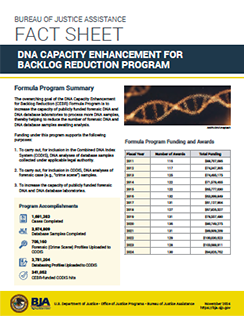The DNA Capacity Enhancement for Backlog Reduction (CEBR) Program provides funding to states and units of local government with existing crime laboratories that conduct DNA analysis. The goal of the program is to increase the capacity of publicly funded forensic DNA and DNA database laboratories to process more DNA samples, thereby helping to reduce the number of forensic DNA and DNA database samples awaiting analysis.
Eligibility Requirements
Eligible applicants are states and units of local government with existing crime laboratories or laboratory systems that conduct forensic DNA and/or DNA database sample analysis.
Among other things, eligibility for CEBR funding requires government laboratories to be accredited and have access to the Combined DNA Index System (CODIS). See the Resources page for additional information on eligibility certification. Typically, more laboratories become eligible for funding under the CEBR Program by achieving accreditation and gaining CODIS access which is demonstrated by a general increase in awards over the years. However, decreases in awards may be seen if laboratories choose not to seek funding, fail to meet the eligibility requirements, or opt for the state laboratory to manage the award for all participating laboratories within the state (which then participate as subgrantees to the state).
View the fact sheet.
History of the CEBR Program
The DNA Identification Act of 1994 authorized the creation of NDIS and provided the first funds for capacity building purposes. The DNA Backlog Elimination Act of 2000 authorized the Department of Justice to provide grants for state and local laboratories to process samples for inclusion in the FBI’s CODIS. In 2004, the DNA Backlog Elimination Act was reauthorized and renamed the “Debbie Smith Act” after sexual assault survivor Debbie Smith. The legislation authorizes funding for eligible public laboratories to (1) process DNA samples for inclusion in CODIS and (2) increase the capacity of laboratories to process DNA samples for inclusion in CODIS.
When the grant program was first offered in 2005, it contained two related components: (1) the Forensic DNA Capacity Enhancement Program and (2) the Forensic DNA Casework Reduction Program. In fiscal year 2007, the two programs were combined, and in fiscal year 2011, the Convicted Offender and/or Arrestee DNA Backlog Reduction Program was incorporated into the DNA Backlog Reduction Program. The consolidation of the related programs into one program was designed to make it easier for grantees to use federal funds to fulfill their individual needs. The program has since been named the "DNA Capacity Enhancement for Backlog Reduction Program."
Why Is the Program So Important?
As technology advances to improve the analysis of DNA evidence, there is a respective increase in demand for DNA testing. Furthermore, the technology is becoming more complex and costlier, and laboratory budgets struggle to meet the increased demand as identified in DOJ's 2019 Needs Assessment of Forensic Laboratories and Medical Examiner-Coroner Offices. Delays in testing evidence result in delays in justice, which can lead to additional victimization by serial offenders or incarceration of the innocent.
Recent performance data from grantees show that CEBR funding is responsible for more than 500 CODIS hits per week. Based on the reported metrics, the CEBR Program has contributed to approximately half of all CODIS hits to date. See the FBI's CODIS-NDIS Statistics page for more information on CODIS and BJA's DNA CEBR Grantees page for more information on program accomplishments.


